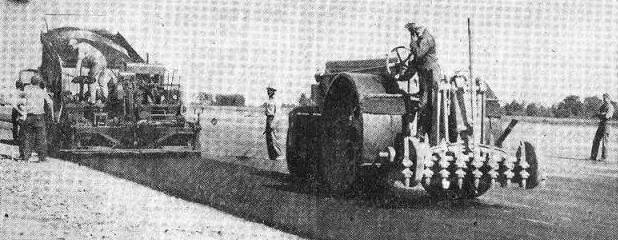SAMPSON
AIR STRIP NEARLY MILE LONG
Elmira Sun Telegram
September 27, 1953
|
 |
|
|
ASPHALT
IS APPLIED
to the new landing field at Sampson Airforce Base near Geneva.
The
landing strip is across from the hospital area. In the picture the
spreader is shown laying asphalt, in 10 foot strips. The roller
follows close behind to prevent ridges forming between stripes.
When completed the air field will contain 108,000 square yards of
pavement including air strip, parking and warm up aprons, roadways and
taxi ways. (Sampson Air Base photo) |
BASE
WITHOUT LANDING FIELD LOSES DOUBTFUL DISTINCTION
by
A/1c Malcom Currie
Sampson
Air Force Base--Sampson will lose one of its unique characteristics early next
year when its new air strip, located adjacent to the hospital base area, will be
completed. At present Sampson retains the dubious distinction of being the
only Air Force base without a landing field.
Albert
Barry, resident engineer of the New York Corps of Engineers, estimates that the
strip itself, parking aprons and taxi ways will be completed by Jan. 1.
BEACON
BUILDING READY
The
homing beacon building, located near the dry firing range in Sampson's Hamilton
area, has been completed at a cost of $11,000.
An
area equal to 75 feet by 2800 feet has received asphalt covering.
Thirty-six inches thick, the actual landing area is composed of select base
material and pavement.
In
preparation for laying of base material contractors moved on half million cubic
yards of earth.
C.
I. Langenfelder and Sons Inc. of Baltimore, who were awarded the contract last
December after a successful bid of $1,464,000, started preliminary work on the
project Jan. 24. The contract calls for clearing, grubbing, and paving the
5,000 by 150 foot area by the Baltimore firm. Runways, taxi-ways, warm-up
aprons, parking area, roadways, gasoline storage, and night lighting are also
included in the million dollar project.
Ardini
and Pfau of Syracuse submitted the winning bid on $365,000 for construction of
the operations building, receiver and transmitter buildings, and other necessary
structures on the field. Construction of hangers is not specified under the
present contract.
TO
TRANSPORT WOUNDED
The
airstrip was constructed primarily to (1) transport wounded men to Sampson's
1,000 bed hospital in the event of a war in Europe. (2) to provide proficiency
training for pilot officers stationed here, and (3) to move trainees and
supplies directly to and from the base instead of employing the present system
which depends on Hancock Field in Syracuse.
With
all present air operations for the base being conducted at Hancock Field, a
problem of ground transportation between Sampson and Syracuse exists -- a
problem which the new strip will alleviate. After completion of the
landing field, every air trip from Sampson will be lessened by some four hours.
The type of aircraft which can land at the new strip will be limited only by the
length and width of the landing area, not by the type of air strip construction.
